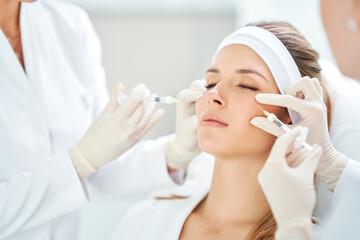A very popular and widely used cosmetic procedure is Botox procedure. While the name of this procedure is very commonly heard, other details such as treatment, recovery, and side effects might not be so well known or talked about. In this article, we discuss things to know before you visit a botox clinic richmond.
What is Botox? - A closer look
Botox is the abbreviation for botulinum toxin. It is a purified protein derived from the bacterium Clostridium botulinum. Botulinum toxins are neurotoxins that affect nerves and cause the muscles to weaken. Though popularly known and used in the cosmetic industry to reduce the appearance of fine lines and wrinkles, Botox also has therapeutic uses, such as treating migraine headaches.
How does Botox work?
Botox is administered in small doses by professionals. This small quantity temporarily paralyzes or weakens the muscles by blocking the nerve signals to the targeted muscles. Though temporary, the treatment can last up to several months. One Botox session can also address several target areas or target muscles. This neurotoxin, when administered in small amounts, cleaves certain proteins involved in the release of neurotransmitters and inhibits the release of acetylcholine from the nerve endings, thereby blocking the nerve signals to the targeted muscles.
The cosmetic conditions that Botox treatment can treat ➖
While mostly used to reduce the signs of aging, such as the appearance of fine lines and wrinkles that occur as a result of muscle contractions, Richmond ultherapy and
Botox can be used to treat other conditions such as ➖
- Brow lift - Botox treatment can provide a subtle brow lift for a more sharp appearance.
- Drooping eyelids - Botox treatment can be used to reduce the appearance of drooping eyelids by lifting the outer corners of the eyes.
- Hyperhidrosis - Botox can reduce excessive sweating.
- Neck Bends - The application of Botox in the neck area can reduce neck bends.
- Gummy smiles - The application of Botox can reduce the considerable showing of gums, also known as gummy smiles.
Therapeutic applications of Botox ➖
- Chronic migraines - Botox is administered to treat chronic migraines in adults.
- Muscle Spasms and Dystonia - Botox also treats muscle spasms and cervical dystonia which is a neurological disorder.
- Overactive Bladder and Incontinence - Botox application can treat overactive bladder and urinary incontinence by relaxing the muscles of the bladder.
- Hyperhidrosis - This is a condition of excessive sweating that can be treated by Botox.
- Eye Disorders - Eye disorders such as eye twitching can be cured by Botox.
The procedure of Botox -
The procedure of Botox can be divided into the following stages ➖
- Consultation - The initial stage of the botox treatment, like any other treatment, involves consultation with experienced personnel and booking an appointment for ultherapy richmond. During the consultation period, it is important to let the physician be aware of all the medications that their client is consuming already or if they have any medical condition. The healthcare professional must be made aware of the person’s medical history, desired goals from the Botox treatment, and allergic conditions if any. This will help them decide whether Botox is suitable for that person or not.
- Injection - The treatment procedure of Botox includes a series of small, physician-led injections injected at the targetted muscles.
- Immediate Aftercare - After the treatment procedure, individuals can return to their places and resume their normal activities. However, it is advised to avoid strenuous exercise and alcohol intake shortly after the procedure.
Rest and Recovery after Botox procedure -
It might take a few days or a couple of weeks for the Botox treatment to show visible results, such as a smoother and more youthful appearance of skin.
Though the people undergoing Botox treatment can immediately resume their everyday lives, it is advised for them to avoid strenuous exercise and alcohol intake. It is also advised to avoid massaging or rubbing the treated areas for up to 12 hours after the treatment, as doing so can cause the botox to spread. It is also advised to stay upright for 3 to 4 hours after the treatment.
Potential Side Effects of Botox Treatment
Though the administration of Botox in small quantities is generally safe, there can be chances of certain side effects in some people. The side effects can include -
- Pain, bruising, and swelling at the site of injection.
- Some individuals can experience mild headaches.
- Temporary droopy eyelids can also be a side effect of Botox treatment.
- Some people can develop allergic reactions and experience temporary weakness as a side effect of Botox treatment.
Cosmetic clinics that provide services such as laser hair removal Richmond bc, also offer Botox treatment. It is always advised to undergo cosmetic treatments at trustworthy cosmetic clinics under the supervision of experienced professionals. Though usually a safe procedure, people suffering from neuromuscular diseases are advised not to undergo Botox treatment.
